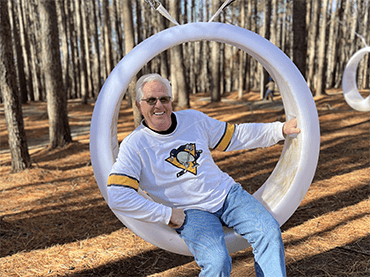On a summer day in June 2024, Jim was mowing his lawn when he began to experience chest pain that radiated down his arm. After feeling the pain, he took a break for a few minutes and then started to mow again. The same thing happened two to three times more until the yard was done.
Jim was already scheduled to see his primary care physician, Joshua Berger, DO. During his appointment, Dr. Berger listened to Jim’s concerns and decided that his next step was to have a stress test.
“I lasted on the treadmill for seven minutes,” Jim recalls. Normally, stress tests last around 15 minutes. However, if the care team notices something wrong, they will stop the test. In Jim’s case, something was wrong.
The team recommended that Jim undergo a heart catheterization. At the time, he didn’t have a cardiologist, so his wife did some research and found the UPMC Heart and Vascular Institute.
The UPMC Heart and Vascular Institute provides advanced cardiovascular care to patients with heart and vascular disease. Our multidisciplinary team collaborates across various specialties to ensure patients receive comprehensive care at every stage.
To achieve this goal, interventional cardiologists and cardiac surgeons at UPMC Presbyterian recently launched a dedicated Advanced Revascularization Clinic. This specialty clinic offers a convenient, single evaluation from experts in multiple specialties who construct a plan of care specific to the patient’s needs. That plan often includes the most innovative treatments available, including robotic cardiac surgery and advanced catheter-based coronary treatments.
At the beginning of September, Jim underwent a heart catheterization, which revealed a 90% blockage in the left anterior descending (LAD) artery which runs along the front of the heart, as well as significant disease of his right coronary artery (RCA), the artery that runs along the back of the heart. If left untreated, Jim would likely experience a heart attack or even sudden cardiac death.
With multiple blockages, most institutions would have recommended that Jim have a triple bypass through traditional open-heart surgery.
However, in October, Jim had a consultation at the UPMC Advanced Revascularization Clinic. At that visit, his case was reviewed by cardiac surgeon Johannes Bonatti, MD, and interventional cardiologist, Catalin Toma, MD, who together agreed that Jim would be a good candidate for a minimally invasive hybrid approach to include a robotically-assisted total endoscopic double coronary artery bypass (TECAB) of his LAD and ramus arteries, followed by stenting of the remaining RCA disease.
During a robotically-assisted TECAB, surgeons make multiple small incisions between the ribs. Then, surgical instruments – along with a tiny camera – are inserted through the incisions. The surgical tools are connected to robotic arms that the surgeon controls from a computerized console.
The robotic 3-D, high-definition camera gives a highly magnified view, allowing the surgeon to perform the procedure more precisely. The bypasses are stitched to the coronary artery so that more blood flows into the heart muscle.
Performing heart procedures robotically has many benefits for the patient. This minimally invasive procedure results in less surgical trauma, fewer postoperative restrictions, and a quicker recovery.
Later in October, Jim underwent TECAB with Dr. Bonatti, followed two days later by stenting of the right coronary artery by Dr. Toma, during the same hospital stay. He was successfully discharged home the following week.
Thanks to the experts at UPMC and the multidisciplinary approach offered in the UPMC Advanced Revascularization Clinic, Jim was able to avoid open heart surgery and receive complete treatment of his multivessel coronary disease.
During his postoperative recovery at the hospital, Jim describes his experience with the team at UPMC with high praise.
“Everybody was better than the person before. Upon a shift change, I told the nurse that he or she had big shoes to fill (from the nurse prior),” says Jim. "I think they took that as a challenge, because they certainly lived up to it! Despite being in the hospital, I had a very nice experience."
Jim calls the recovery “easy.” During his second postoperative appointment two weeks after his procedure, Jim did the “six-minute test.” The test involves walking the halls for six minutes and having your oxygen levels and pulse checked every minute. Jim was able to do 26 laps. Dr. Bonatti had a smile on his face and told Jim, “No one has ever done 26 laps that early.”
After his four-week postoperative visit, Dr. Bonatti was pleased with Jim’s progress and instructed him to continue exercising and maintaining a heart-healthy diet. Jim’s goal was to surpass his previous baseline of health and improve upon it.
Jim continues to work on improving his health, including many walks around his neighborhood.
Coming from a small town that is a distance from Pittsburgh, Jim wanted to share his experience with others.
“The personalized care and attention decreased my stress level and made this experience a much better one,” Jim recalls. “I was apprehensive about traveling into the city and navigating a hospital I was unfamiliar with, in addition to being anxious about my upcoming surgery. However, the hospital staff went out of their way to guide me to where I needed to be."
Jim’s treatment and results may not be representative of all similar cases.

















